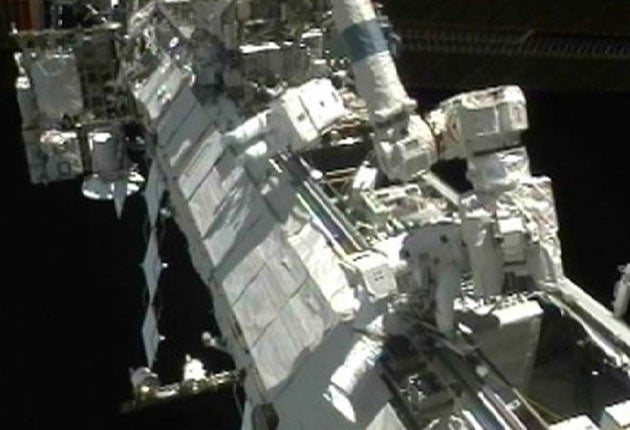Spacewalk fails to replace pump that keeps space station cooled

Faced with a rare and potentially critical maintenance crisis aboard the International Space Station, directors at Nasa's mission control are expected to wait until Wednesday before allowing two astronauts to resume efforts to replace a cooling unit that stopped working more than a week ago.
The delay leaves the station in an unusually vulnerable position with only one of its two cooling loops working. The system has to combat heat generated by the experiments on board but also the extremes of temperature that arise naturally. On the sun-facing side of the station, temperatures can reach 121 Celsius while on the dark side they can plunge to minus 157C.
The delay gives engineers at NASA extra time to rethink their plans after an attempt over the weekend to remove the failed 780lb pump and replace it with a spare unit hit an unexpected glitch. While the safety of the six-member crew – three Americans and three Russians – does not appear to have been seriously compromised, this latest breakdown aboard the station comes at an awkward time as politicians in Washington struggle to set policy and funding for the space agency.
At just over eight hours, the weekend's space-walk by astronauts Douglas Wheelock and Tracy Caldwell was the longest in the history of the space station. But they were scotched first by an ammonia line that at first would not disconnect. Then the line sprang a leak, spraying both space-walkers with ammonia crystals. "Wow, that thing is not budging," Wheelock was heard telling mission control at one point, before he was authorised to use brute force, hitting the line connector with a hammer. Once loosened, the line had to be reconnected because of the unexpected leak. The pressure is now on engineers on the ground to figure out how to tackle the leak and, with luck, get the pump replaced soon.
Most of the experiments aboard the station, a joint US-Russia venture born in 1998, have been suspended while the thermostat problem persists. For now, the temperature in the station is being controlled by the second of its two cooling loops. Were that to fail, the crew would be forced to retreat to the Russian section of the orbiting complex which has its own cooling system.
As Nasa prepares to retire its shuttle fleet sometime next year, the International Space Station is about to take centre stage in American space exploration and any suggestion that it could somehow fail will hardly be welcome. Indeed, members of the US Senate only last Thursday approved a new $19bn (£12bn) spending bill for Nasa which includes provisions to extend the life of the station by five years to 2020.
That the station is not infallible has been well advertised before, not least when its toilets have periodically ceased to function. There have also been problems with the arms that house the extensive solar panels powering the station.
Exactly what caused the cooling pump to blow is still not known, but there have been some reports that a power surge was to blame. "ISS is a living, breathing beast," Michael Suffredini, the space station manager, said recently. "Some days everything doesn't exactly work perfectly."
Even assuming the defunct unit is successfully replaced this week, NASA will now have to examine if it has the capacity to replace the spare that will be used.
"The recent breakdown of the station's cooling system emphasises how critical it is that we understand all of the equipment needs the space station will have as its service life is extended," noted Senator Kay Bailey Hutchison of Texas. "We must assure that Nasa has a plan to deliver those elements or bring parts down for analysis and repair once the space shuttle is finally retired."
Designed as an orbiting research facility as well as a laboratory for private space firms, the space station risks becoming the sole visible reason for Nasa's existence until Washington can agree on what is next for American space exploration.
The Senate Bill, which must now be melded with a less expansive version passed by the House of Representatives, envisages keeping the shuttle fleet flying for one more year, channelling money to the private space sector, which one day will provide vehicles to put astronauts in space, and developing a heavy-lift rocket for manned flight beyond Earth's orbit, for instance to the Moon or Mars.
But the package is attracting criticism partly for providing too little money for such goals to be met. "With the funding for Nasa not likely to change, bold plans for humans in space are simply not feasible," The Washington Post said in an editorial yesterday. "Something must give."
Join our commenting forum
Join thought-provoking conversations, follow other Independent readers and see their replies
Comments